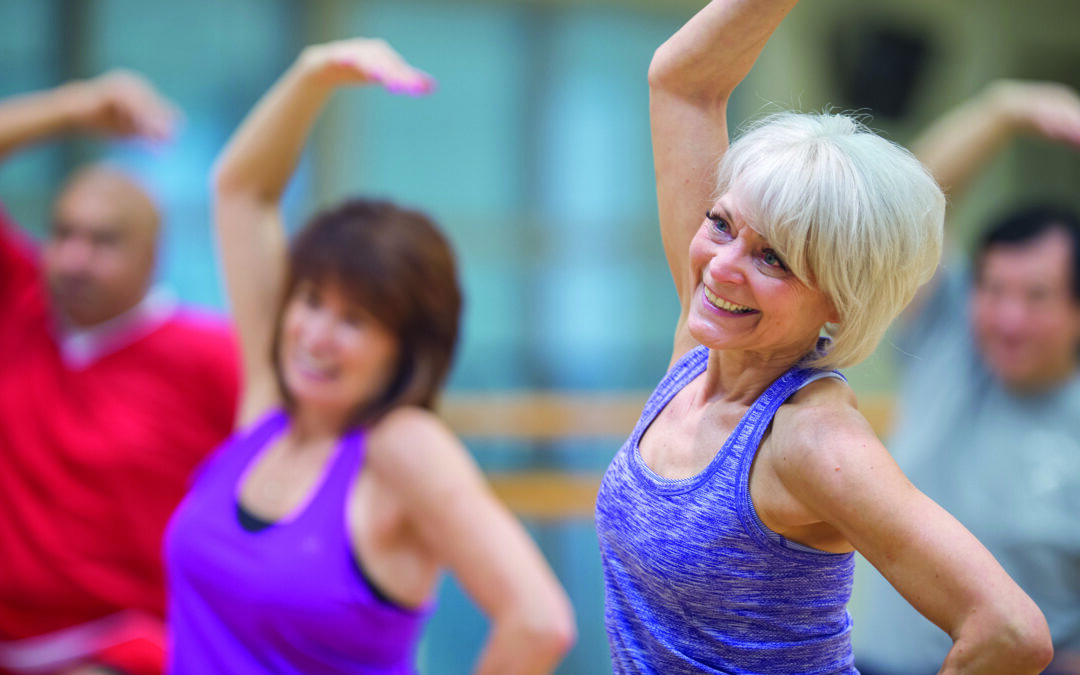
by jsurdej | Dec 11, 2017 | Physical Therapy News
Want to make resolutions you’ll keep this new year? Think simple, sustainable changes. Follow these four steps for a healthier you, inside and out.
Stick to Your Workout
After the holidays, the gym is filled with people who have resolved to incorporate exercise routines into their lives. Come February, the novelty of the new year wears off, life gets in the way and, according to U.S. News & World Report, 80 percent of resolutions fail by the second week of the month.
Instead of jumping from no routine to a seven-days-a-week commitment, introduce workouts to your schedule in small doses. Dread cardio or weight machines? Find something that you’ll look forward to like a cycling class, yoga or outdoor pursuits. Choosing activities that you enjoy will increase your chances of sticking to your resolution.
Eat Smarter
According to the Centers for Disease Control and Prevention, most Americans are falling short of their fruit and vegetable intake goals, and most eat only half the recommended amount of fiber. To increase your consumption of essential nutrients, create a grocery list packed with fruits, vegetables, protein and whole grains.
Plan meals for the week to ensure you stick to a whole-food menu. Keep ingredients on hand for meals you can make in a pinch, so you’re not tempted by fast food on a busy day. Try frozen salmon fillets, which you can cook without thawing, or eggs, low-fat cheese and veggies for a quick-baking frittata.
Freeze individual servings of chopped fruits and vegetables in resealable bags to create quick and delicious smoothies each morning in a high-powered blender, such as the Vitamix E310 Explorian Series machine. For a satisfying, energy-boosting snack, use your blender to pre-make Dried Fruit Chia Bars or White Chocolate Peanut Butter Energy Balls.
Stress Less
Stress can have adverse effects on minds and bodies, as insomnia, weight gain, anxiety and depression are all potential related risks. While it isn’t always avoidable, simple changes will help you manage tension.
Sometimes, stress can be solved with some “me time.” Treat yourself to a massage or manicure, soak in a hot bath, or unwind with a nature walk. Connecting with others can help, too. Plan a brunch with your best friend or a date night with your significant other.
Feeling overwhelmed with work and family life? Build out a to-do list or calendar to feel more in control of your busy schedule, then cross items off the list when completed.
Practice Positivity
A sunny outlook can affect your wellbeing. Keep a gratitude journal by writing down something good that happens each day. On bad days, you’ll be forced to focus on the positive aspects of your life.
One of the best ways to improve your happiness is by giving others a boost. Volunteer with a charitable organization or donate to a favorite cause. Practice doing something kind daily.
This new year, take small steps to help you feel happier and healthier.
— StatePoint
ProActive Sports Rehab, with offices in Hamburg and West Seneca, offers one-on-one physical therapy and rehabilitation services. For more information, please call 674-9600 (West Seneca office) or 648-8700 (Hamburg office). You can also follow ProActive Sports Rehab on Facebook at www.facebook.com/ProActiveSportsRehab for frequent updates.

by jsurdej | Dec 4, 2017 | Physical Therapy News
The most common injuries in skiing happen to the lower limb, most commonly the knee. The introduction of releasable bindings has decreased the rate of leg fractures by 90 percent in the past 30 years, but knee sprains (including ACL and/or MCL tears) are on the rise accounting for about 30 percent of all skiing injuries.
The most common injury is the medial collateral ligament (MCL) tear, which is typically treated without surgery. In skiing, the MCL is often torn when the ski tips are pointed toward one another in a snowplow position (the common slow or stop position) and the skier falls down the hill. MCL tears are more common among beginning and intermediate skiers than advanced and elite skiers. When skiing you may prevent an MCL tear by:
- Making sure that your weight is balanced when you are in the snowplow position.
- Sticking to terrain that is a comfortable challenge but not overwhelming.
The second most common injury is the anterior cruciate ligament (ACL) tear. Given the importance of the ACL to the functional stability of the knee, ACL tears often require surgery (however in some cases patients can avoid surgery). ACL tears are common in sports, but most of them are the result of “non-contact” injuries.
There are two ways that skiers most commonly tear the ACL:
• Landing a jump in poor form. When skiers land from a jump with their weight back, so the back of the boot is pushing on the calf, the force from landing can tear the ACL. The best way to avoid this injury is to learn to land safely, with your weight forward, by starting with simple jumps and gradually advancing to more difficult jumps.
• The “phantom foot” phenomenon often happens when skiers try to stand up to prevent an unavoidable fall. As the skier falls, all the weight goes on the outside of one ski, and the arms and trunk rotate away from that leg. When a skier falls into this position, an ACL injury is often the result. Avoid this position by never trying to stand up during a fall and accepting an unavoidable fall. Skiers should “go” with the momentum of a fall and maintaining good ski technique.
- Preventing injury on the slopes
- Remember the keys to effective skiing technique: Hands and weight forward, legs parallel, and hips, knees and ankles flexing equally.
Stay on marked trails: Going off trail can take you into ungroomed territory with many possible obstacles (such as trees and rocks) that can contribute to injuries. - Getting ready for the slopes
- Prepare your body. A few simple exercises can prepare your core and lower extremities for skiing. Three to four weeks of aerobic training such as walking, elliptical or biking can be excellent ways to help you tolerate a full day on the slopes.
- Ensure you have proper equipment: Make sure ski boots, bindings, and ski length are fit and appropriate for your height and skill level. Wear a helmet. Wrist guards are a good idea if snowboarding.
- Learn proper technique: Take a skiing technique class with a professional before you hit the slopes.
- Rest: If you are tired, rest. Injuries happen more commonly when skiers are fatigued.
— American Physical Therapy Association
ProActive Sports Rehab, with offices in Hamburg and West Seneca, offers one-on-one physical therapy and rehabilitation services. For more information, please call 674-9600 (West Seneca office) or 648-8700 (Hamburg office). You can also follow ProActive Sports Rehab on Facebook at www.facebook.com/ProActiveSportsRehab for frequent updates.

by jsurdej | Nov 27, 2017 | Physical Therapy News
 Staying healthy can be a challenge, especially for those living with diabetes. Everyone can have conflicts finding the right balance of partaking in healthy habits, such as exercise, eating well and even keeping your teeth and gums clean. From stress to self-care, life can be up and down when you’re living with diabetes.
Staying healthy can be a challenge, especially for those living with diabetes. Everyone can have conflicts finding the right balance of partaking in healthy habits, such as exercise, eating well and even keeping your teeth and gums clean. From stress to self-care, life can be up and down when you’re living with diabetes.
These seven tips from Dr. Natalie Strand, the winner of season 17 of “The Amazing Race” who lives with diabetes herself, can help you stay healthy and lead a balanced life while managing your diabetes.
Communicate with your care team. Make sure you connect with your nurse educator, endocrinologist, dietician and physical therapist. Reach out to them with your questions as they can often help you implement subtle changes to avoid completely overhauling your lifestyle and routine because of diabetes.
Get involved. Get a local group together to fundraise, vent or just understand each other. Groups such as Diabetes Sisters, JDRF, TuDiabetes and BeyondType1 offer ways to connect with others living with diabetes in person or on social media. Connecting with the diabetes community can be a powerful way to help ease the burden of living with diabetes.
Keep doing what you love. Just because you have diabetes doesn’t mean you have to give up doing what you love. Make efforts to continue sports, travel and other hobbies, even if there is a learning curve to adapting with diabetes at first.
Maintain good oral health. People living with diabetes are two times more likely to develop gum disease, according to the Centers for Disease Control. Colgate Total toothpaste is FDA-approved to help reverse and prevent gingivitis, an early form of gum disease.
Get into a routine. Find a routine that works and stick with it. This way you don’t have to make new decisions each day. Anything that can ease the mental burden of diabetes can help. For example, pick a time each year for your annual visits: eye doctor, endocrinologist, renew prescriptions, etc. Picking the same time of year every year can help ensure you don’t forget to take care of yourself.
Make self-care a priority. It can be hard to keep diabetes care in the forefront. It can be boring, exhausting and also fade into the background. Remind yourself that one of the best things you can do for yourself, and for your loved ones, is stay healthy. Use your family as motivation to exercise daily, eat better-for-you foods and maintain a healthy weight.
Manage stress. Diabetes can be a big stressor. Add jobs, kids, relationships and it can become overwhelming. Find an easy and effective tool for stress relief and do it often. Even five to 10 minutes of guided meditation daily can have a big impact on stress management.
For more information and ways to lead a balanced life with diabetes, visit OralHealthandDiabetes.com.
— Family Features
ProActive Sports Rehab, with offices in Hamburg and West Seneca, offers one-on-one physical therapy and rehabilitation services. For more information, please call 674-9600 (West Seneca office) or 648-8700 (Hamburg office). You can also follow ProActive Sports Rehab on Facebook at www.facebook.com/ProActiveSportsRehab for frequent updates. Photo courtesy of Getty Images.
by jsurdej | Nov 20, 2017 | Physical Therapy News
As America combats a devastating opioid epidemic, safer, non-opioid treatments have never been of greater need.
Physical therapy is among the safe, effective alternatives recommended by the Centers for Disease Control and Prevention in guidelines urging the avoidance of opioids for most pain treatment. Whereas opioids only mask the sensation of pain, physical therapists treat pain through movement.
Here’s how:
1. Exercise. A study following 20,000 people over 11 years found that those who exercised on a regular basis experienced less pain. And among those who exercised more than three times per week, chronic widespread pain was 28 percent less common. Physical therapists can prescribe exercise specific to your goals and needs.
2. Manual Therapy. Research supports a hands-on approach to treating pain. From carpal tunnel syndrome to low back pain, this type of care can effectively reduce your pain and improve your movement. Physical therapists may use manipulation, joint and soft tissue mobilizations, and other strategies in your care.
3. Education. A large study conducted with military personnel demonstrated that those with back pain who received a 45-minute educational session about pain were less likely to seek treatment than their peers who didn’t receive education about pain. Physical therapists will talk with you to make sure they understand your pain history, and help set realistic expectations about your treatment.
4. Teamwork. Recent studies have shown that developing a positive relationship with your physical therapist and being an active participant in your own recovery can impact your success. This is likely because physical therapists are able to directly work with you and assess how your pain responds to treatment.
— American Physical Therapy Association
ProActive Sports Rehab, with offices in Hamburg and West Seneca, offers one-on-one physical therapy and rehabilitation services. For more information, please call 674-9600 (West Seneca office) or 648-8700 (Hamburg office). You can also follow ProActive Sports Rehab on Facebook at www.facebook.com/ProActiveSportsRehab for frequent updates.

by jsurdej | Nov 13, 2017 | Physical Therapy News
Fall means not only shorter days and colorful leaves, but also the season of open enrollment for health insurance for most Americans.
Employer-sponsored benefits can be confusing, and a combination of doing some homework and seeking expert advice can help most individuals make the most of the plans available to them.
Confusion over health insurance remains a common problem; approximately 76 percent of American workers reported that they did not understand some elements of their health insurance, according to the 2017 Aflac WorkForces Report conducted by Lightspeed GMI on behalf of insurance provider Aflac.
Areas of concern reported by survey respondents included deductibles, copays and the determination of whether a health care provider is in-network.
Consumer education is the key to making smart decisions during open enrollment periods, according to Aflac, which offers three top tips for maximizing health insurance.
• Be prepared. Take the time to look into all the available options. Data from Aflac’s consumer survey showed that 83 percent of workers spent less than an hour researching potential health insurance benefit plans, and 20 percent of those did no research on health insurance plans at all.
• Be advised. Get expert help. The Aflac survey found that approximately two-thirds (67 percent) of workers said they were confident that they understood all aspects of the health insurance plans for which they signed up. However, only 24 percent said they understood everything when they were questioned in more detail about deductibles, copays and in-network providers.
• Be enhanced. Consider additional voluntary insurance coverage to help fill the holes in employer-offered plans. Approximately 81 percent of employees report a need for voluntary insurance benefits, according to the Aflac survey, and 90 percent say that they view voluntary insurance as essential to a complete health benefits program.
Some examples of voluntary insurance include not only health insurance, but also accident insurance, insurance for critical illness and insurance for hospital stays, which may not be covered by an employer’s insurance. Voluntary insurance also can be used to help with expenses associated with gas, groceries and rent for individuals with illnesses or injuries that prevent them from working.
Visit aflac.com for more information about options for health benefits and how to choose a benefits plan.
— NewsUSA
ProActive Sports Rehab, with offices in Hamburg and West Seneca, offers one-on-one physical therapy and rehabilitation services. For more information, please call 674-9600 (West Seneca office) or 648-8700 (Hamburg office). You can also follow ProActive Sports Rehab on Facebook at www.facebook.com/ProActiveSportsRehab for frequent updates.

by jsurdej | Nov 6, 2017 | Physical Therapy News
 One in two women over the age of 50 will suffer a fracture caused by osteoporosis in her remaining lifetime. Despite its prevalence, there are many myths and misconceptions about this “silent” disease. These myths may be a reason why osteoporosis is underdiagnosed and undertreated.
One in two women over the age of 50 will suffer a fracture caused by osteoporosis in her remaining lifetime. Despite its prevalence, there are many myths and misconceptions about this “silent” disease. These myths may be a reason why osteoporosis is underdiagnosed and undertreated.
A fragility fracture (breaking a bone by falling from a standing height or lower) can impact day-to-day life, but it can also be an indicator for osteoporosis in postmenopausal women. When you have osteoporosis, even daily tasks such as taking your dog for a walk can put you at risk for a fragility fracture of the wrist, leg or even hip. But, a startling 82 percent of postmenopausal women did not identify such fractures as a possible risk factor for osteoporosis, according to results from a recent online survey of over 1,000 postmenopausal women conducted by Harris Poll on behalf of Radius Health, in partnership with HealthyWomen and the National Osteoporosis Foundation.
That first fracture should be your cue to talk to your physical therapist or health care professional about treatment options that may lower your risk of breaking a bone again.
“It is critical that postmenopausal women do not dismiss seemingly insignificant fragility fractures as ‘clumsiness,’ but instead see them as an important indicator for bone fragility, disease progression and the need for intervention,” says Dr. Andrea Singer, MD, FACP, CCD, clinical director and trustee of the National Osteoporosis Foundation.
This is just one myth about osteoporosis. There are many others, including:
Myth: Osteoporosis only affects the elderly.
Truth: Osteoporosis often affects women after menopause. Natural menopause can occur as early as age 50. The rate of bone loss after menopause is increased with the accompanying loss of estrogen. Osteoporosis is a progressive disease that lowers the density of bones over time, making them weaker and more likely to fracture.
Myth: Osteoporosis isn’t very common.
Truth: Ten million Americans are estimated to have osteoporosis, and more than eight million of those are women.
Myth: Osteoporosis isn’t that serious.
Truth: More women over the age of 55 were hospitalized in the United States for osteoporosis-related fractures than for stroke, heart attack or breast cancer. Yet, according to the survey, postmenopausal women were more likely to be concerned with a diagnosis of stroke, heart attack and breast cancer than osteoporosis.
Myth: Health care providers will tell you when it’s time to test for osteoporosis.
Truth: Research suggests only two in 10 older women in the United States who suffer a fracture are tested or treated for osteoporosis. Furthermore, according to the survey, 96 percent of postmenopausal women who have not yet been diagnosed with osteoporosis and who suffered a fragility fracture were not told by their health care provider it could be linked to osteoporosis.
Myth: Getting enough calcium and vitamin D is enough to treat osteoporosis.
Truth: About three in 10 postmenopausal women incorrectly believe that drinking milk or taking calcium supplements alone will prevent osteoporotic fractures/breaks, the survey found. While getting enough calcium and vitamin D is critical to keep bones strong, it may not be enough when it comes to treating osteoporosis in postmenopausal women, especially after a fracture. It’s important to learn about osteoporosis and talk to your health care professional.
Myth: There is no way to build new bone after menopause.
Truth: About one-quarter of postmenopausal women incorrectly believe there is no way to build new bone at their age, the survey found. The truth is that certain types of treatment for postmenopausal osteoporosis can help build new bone, while others help slow bone loss.
Separating the truths from the myths is an important step in pursuing appropriate care for bone health after menopause. To get more information about osteoporosis, visit the Fractured Truth website at www.fracturedtruths.com. To learn more and find a community of supportive women, visit the Fractured Truth Facebook page at www.facebook.com/FracturedTruth.
— Brandpoint
ProActive Sports Rehab, with offices in Hamburg and West Seneca, offers one-on-one physical therapy and rehabilitation services. For more information, please visit https://proactivesportsrehab.com or call 674-9600 (West Seneca office) or 648-8700 (Hamburg office). You can also follow ProActive Sports Rehab on Facebook at www.facebook.com/ProActiveSportsRehab for frequent updates.




 Staying healthy can be a challenge, especially for those living with diabetes. Everyone can have conflicts finding the right balance of partaking in healthy habits, such as exercise, eating well and even keeping your teeth and gums clean. From stress to self-care, life can be up and down when you’re living with diabetes.
Staying healthy can be a challenge, especially for those living with diabetes. Everyone can have conflicts finding the right balance of partaking in healthy habits, such as exercise, eating well and even keeping your teeth and gums clean. From stress to self-care, life can be up and down when you’re living with diabetes. 

 One in two women over the age of 50 will suffer a fracture caused by osteoporosis in her remaining lifetime. Despite its prevalence, there are many myths and misconceptions about this “silent” disease. These myths may be a reason why osteoporosis is underdiagnosed and undertreated.
One in two women over the age of 50 will suffer a fracture caused by osteoporosis in her remaining lifetime. Despite its prevalence, there are many myths and misconceptions about this “silent” disease. These myths may be a reason why osteoporosis is underdiagnosed and undertreated.
Recent Comments